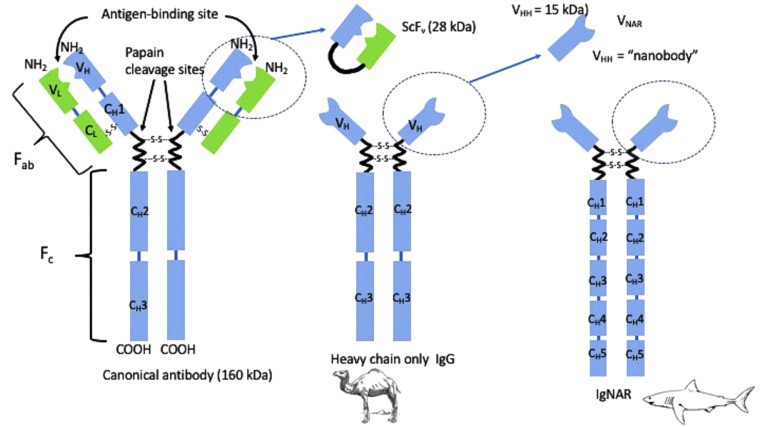Single domain antibodies are a relatively new type of diagnostic probe. Single domain antibodies originated by chance in the process of camelid serum assays. The immune system of the camelid family (camels, llamas, and alpacas) has uniquely evolved to produce heavy-chain antibodies. These heavy-chain antibodies contain a single variable antibody structural domain in a smaller functional unit of 12–15 kDa.
Single domain antibodies have many advantages in the diagnostic field, such as they are very stable and heat resistant and therefore do not require refrigeration, especially when incorporated into diagnostic kits. In addition, the simple genetic structure of single domain antibodies allows for simple redesign of the protein to introduce new antigen-binding features or additional labels. Therefore, Creative Biolabs offers comprehensive native camel antibody discovery services and monoclonal camel antibody production services to facilitate its application in the diagnostic field.
 Fig 1. Comparison of the canonical Ig structure with that of heavy-chain-only antibodies. (Pillay, T. S., et al., 2021)
Fig 1. Comparison of the canonical Ig structure with that of heavy-chain-only antibodies. (Pillay, T. S., et al., 2021)
The basis used to measure analytes and biomarkers is ligand binding assays. Ligand binding assays use the binding reaction between an analyte or biomarker and a specific affinity reagent. In immunoassays, the affinity reagent is the antibody. The development of a suitable immunoassay depends on the availability of protein antigens, the generation of an immune response in the host animal, and the subsequent production of antibodies.
The antibodies are mainly monoclonal and polyclonal. Monoclonal antibodies recognize a single epitope and can be produced indefinitely in pure, homogeneous form from hybridomas. However, the size of monoclonal antibodies (150 kDa) makes re-engineering using recombinant methods a challenge. Polyclonal antibodies are inherently variable, and there may be batch-to-batch variation in serum. Polyclonal antibodies have the advantage of being able to recognize multiple epitopes of complex antigens, but inconsistent production hinders their use. At this point, more suitable antibodies as probes are needed.
The unique immune system of camelids allows the production of VHH of 12–15 kDa in size. The VHH molecule is the basis for the production of small recombinant, autonomous single domain antigen-binding fragments (i.e., single domain antibodies).
The process of generating single domain antibodies begins with the immunization of camels. After the immune response develops, B lymphocytes are isolated from peripheral blood or lymph nodes and used to isolate mRNA. mRNA is then used for reverse transcription to generate cDNA and PCR using VHH-specific primers to amplify the VHH gene region, which is then cloned into a phage display expression vector to generate a library.
Single domain antibodies have a number of features that make them uniquely advantageous for diagnostic purposes. The first is the low production cost of single domain antibodies. The small size of single domain antibodies allows for higher production in medium volume bacterial cultures. Secondly, single domain antibodies are easily customizable to meet the requirements of different applications. The genes encoding the single domain antibodies can be easily redesigned, thus facilitating the improvement of their specificity and affinity. Third, single domain antibodies are more stable and have a longer shelf life, which is more relaxed for their shipping and storage conditions. Then, single domain antibodies can target cryptic or hidden epitopes. Finally, single domain antibodies are less immunogenic and faster to clear in blood.
Single domain antibodies have been introduced into various laboratory diagnostic techniques, including but not limited to parasitic infections, bacterial infections, viral infections, toxic molecular infections, and disease diagnosis. In specific detection experiments, single domain antibodies are currently used in lateral flow assays, ELISA, immunofluorescence analysis, immunohistochemistry techniques, low-frequency immunosorbent assays, and others.
At present, the widespread replacement of classical monoclonal antibodies with single domain antibodies for diagnostic applications requires further efforts. However, single domain antibodies have a unique advantage in the field of in vivo noninvasive imaging. Given the small size of single domain antibodies, they can rapidly extravasate from veins and diffuse uniformly into tissues to reach their targets. In addition, excess single domain antibodies can be quickly removed from the bloodstream through the kidneys. Therefore, the use of single domain antibodies in diagnostic applications is likely to continue to increase.
Reference
All listed services and products are For Research Use Only. Do Not use in any diagnostic or therapeutic applications.